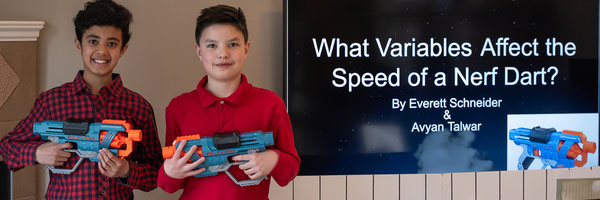What variables affect the speed of a Nerf bullet?
Grade 5
Presentation
Hypothesis
Hypotheses
We tested five variables to see how they affect the speed of a Nerf dart. All of these variables will be compared aganist the control darts which were just normal darts taken out of a new package. The darts we used were Nerf Elite 2.0 darts for all the tests i.e. controlled, holes in dart, heavy dart, short dart and cold dart. We used a different brand i.e. X-shot brand, for one of the manipulated variables.
Below are the variables we tested and the hypothesis we made for each variable.
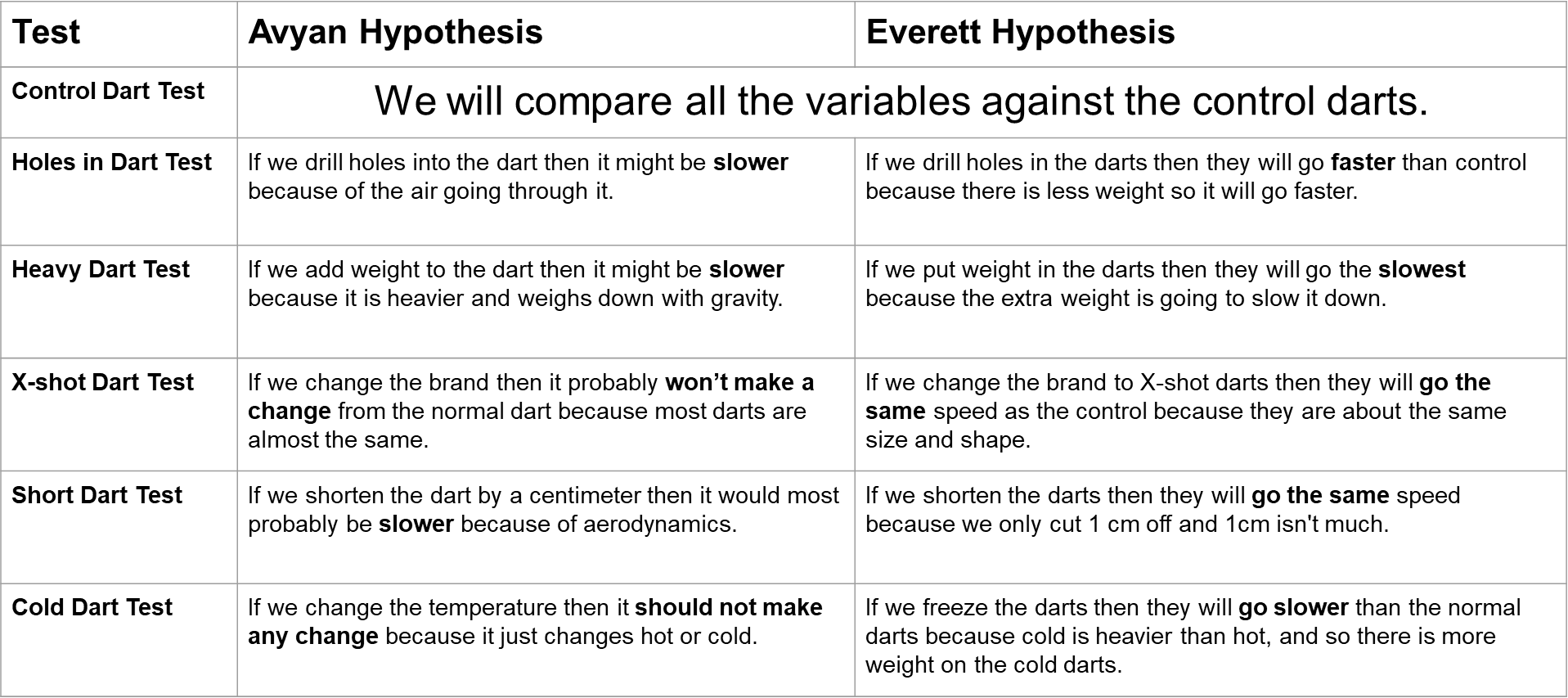
Research
Research
Before we started the tests we had to figure out 'How a Nerf gun works'? After some research, we learned that a Nerf gun works with the principle of air pressure. When you pull back the top slider of the Nerf gun, a spring connected to a piston is compressed. When the trigger is pulled, the spring decompresses rapidly and the piston moves forward with it. This sudden release of kinetic energy creates a burst of air pressure from the piston, which pushes the dart out of the barrel towards the target.

Figure 1: An inside view of a Nerf gun1
Then we had to figure out "What is speed?". After some searching on Google, we had an a answer. Speed is a measurement of how fast an object is moving. The formula for speed is:
Speed = Distance / Time
- To measure the distance, I used a speed board
- To measure time, we used an iphone camera (slow motion, recording at 240 frames per second)
Here is an example calculation of the speed of a dart:
1 second / 240 frames = 0.004167 seconds/frame
15 frames = 0.004167 x 15 = 0.0625 seconds
Speed = 1.3 metres / 0.0625 seconds = 20.8 m/s

Figure 2: Frame 1 which shows the dart at the start of the speed board Figure 3: Frame 15 which shows the dart traveled 1.3m
Here are some references for how a Nerf gun works, how we came up with the idea to use a speedboard and how to measure time using an iphone camera recording in slow motion.
- https://www.facebook.com/jaredowenanimations/videos/nerf-guns-are-actually-quite-complex-on-the-inside-from-the-piston-all-the-way-t/570583970058471/ (how a nerf gun works, Jared Owen)
- https://www.youtube.com/watch?v=P_6my53IlxY (the idea of a speedboard, Mark Rober)
- https://www.topendsports.com/biomechanics/video-analysis-speed.htm (calculating speed using video analysis, topendsports.com)
Variables
Variables
We wanted the most accurate tests so we had to control certain variables. The controlled variables for this experiment are:
- using the same Nerf gun for all tests
- testing in the same area where there is no wind
- the distance between the Nerf gun & the speed board is the same
- the room temperature stays the same
We tested the manipulated variables to see what makes the dart go the fastest. The manipulated variables for this experiment are:
- holes in darts
- heavy darts (putting things into the dart)
- different brand of darts (Nerf vs. X-shot darts)
- length (shortening the darts)
- cold darts
The responding variable in this experiment is the speed of the dart.
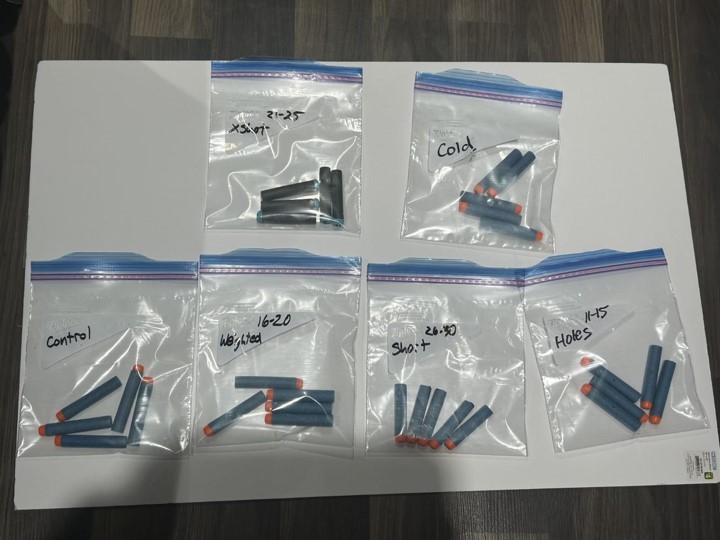
Figure 4: The prepared darts
Procedure
Procedure
The procedure for this experiment is as follows.
1. Prepare darts
- label each of the 30 darts from 1-30 using a pen
- put 5 darts into a freezer
- drill 4 holes in each of 5 darts
- cut 5 darts each 1 cm shorter
- put 2 magnetic balls and a small piece of plasticine in each of 5 darts
- get 5 X-shot darts
- put darts into zip lock bags to keep them organized and label the bags
2. Set up your testing area
- put a speed board on two chairs
- set up iphone camera and lights to see the darts passing in front of the speed board
- put up a target to aim at when shooting
3. Shoot 5 darts for the control and each variable with the camera recording in slow motion (at 240 fps)
4. Load videos into software (frame grabber app) to count how many frames it takes for the dart to get from the start of the speedboard to the end of the speedboard
5. Record a table with the distance, frames, and time for the dart to reach the end of the speed board
6. Complete calculations of speed for each dart and then calculate the mean and median for each test
7. Analyze results
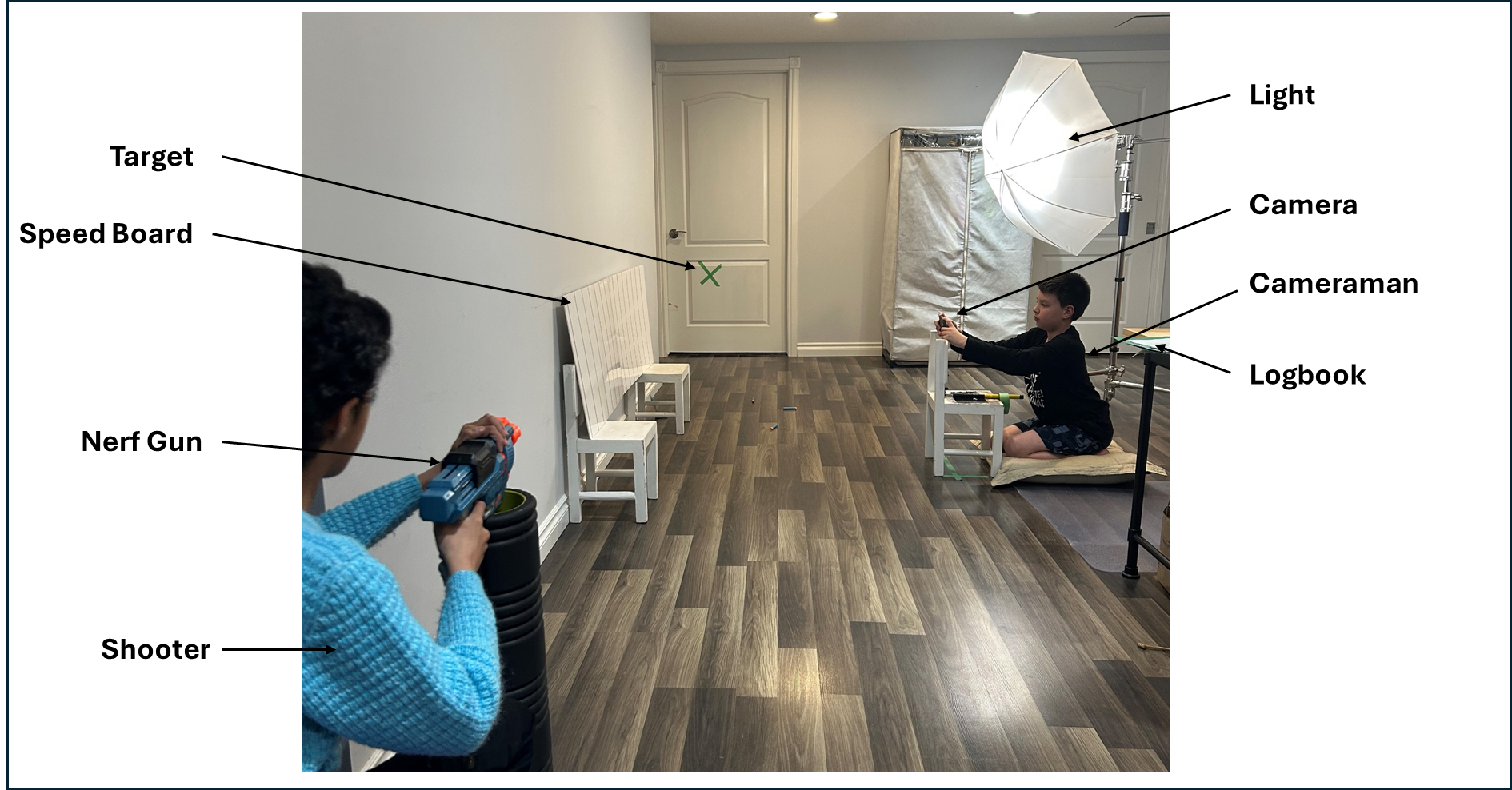
Figure 5: Testing area set up
Here are the materials we used for the experiment.
- Nerf gun (Elite 2.0 commander)
- Different brands of darts (Xshot and Elite 2.0 darts)
- Ruler/measuring tape
- Speed board (Sharpie, white cardboard, glue stick, tape)
- Camera
- Freezer
- Weighing scale (digital at a pharmacy)
- Plasticine
- Scissors
- Chopsticks
- Metallic balls
- Zip lock bags
- Drill
- Temperature Gun
- Drill bits size is 7 / 64 inches
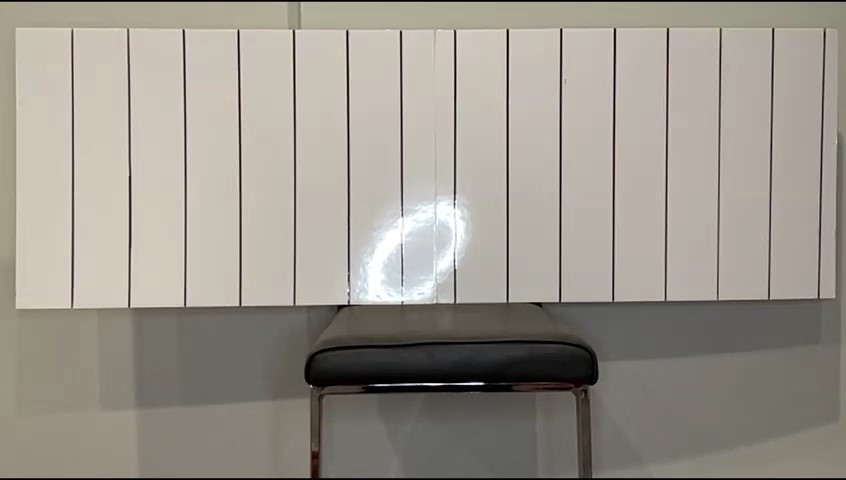
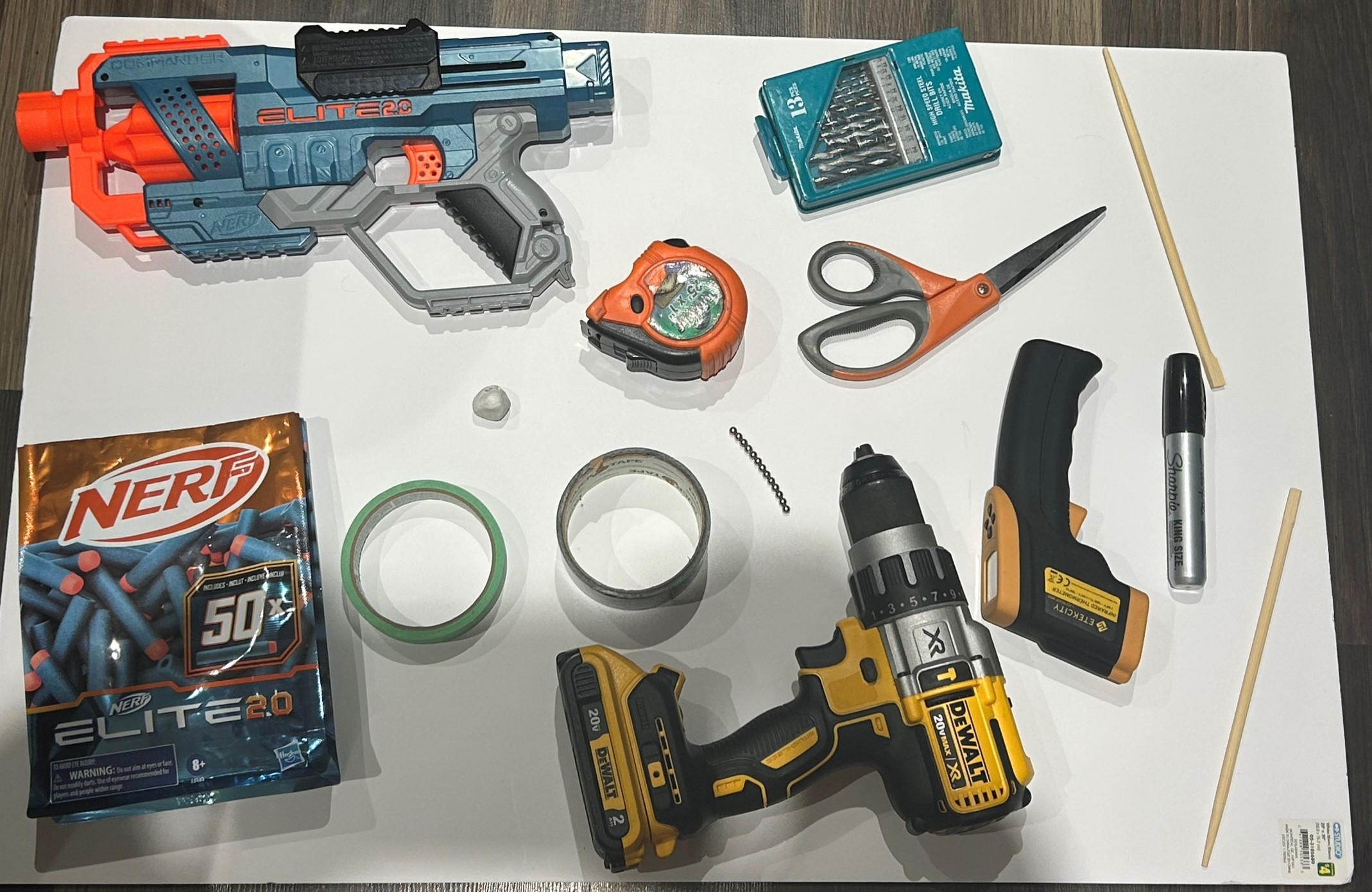
Figure 6: The speed board we made Figure 7: The materials we used
Observations
Observations
Here are the observations from the experiment after calculating the speed for each test.
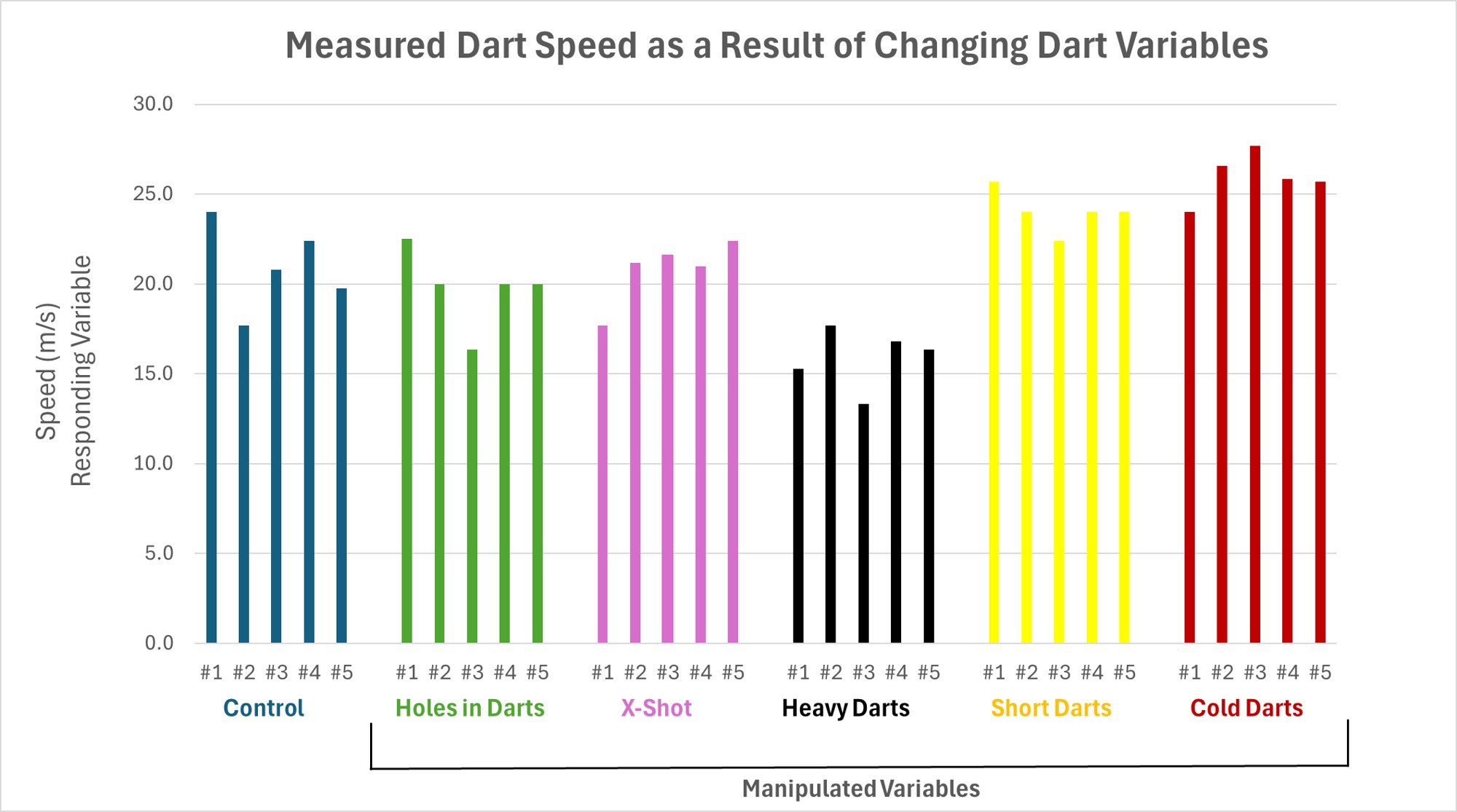
Figure 8: A graph showing the results of each dart that was fired
In this graph you can see that the cold test was the fastest and the heavy darts were the slowest. We will analyze the results more on the next page.
Analysis
Analysis
To analyze the results we calculated the mean and median of speed for the five observations of each test.
We calculated the mean to get the average of each test so we could compare each test against the control. We calculated the median to get a more accurate answer that can get rid of any outlier observation.
Here is the table for the mean and median of each test.
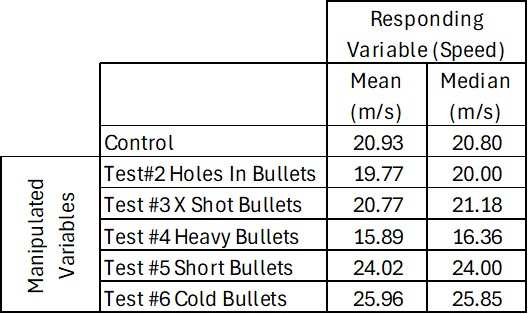
Figure 9: A table of our results
The control darts had a mean speed of 20.93 m/s and a median of 20.80 m/s. When comparing to the control here are results of what darts went faster, slower, or the same.
- The holes in the darts made them slower because the mean and median is less than the control.
- The X-shot was almost the same speed because the mean is lower but the median is higher than the control.
- The heavier darts went slowest because the mean and median were the lowest out of all the tests.
- The shorter dart went faster then the control because the mean and median are higher than the control.
- The colder darts went the fastest because the mean and median are the highest out of all the tests.
Conclusion
Conclusion
In conclusion, making the darts colder or shorter made them faster. Making the darts heavier or drilling holes made them slower.
We believe that drilling holes in the dart makes them slower due to aerodynamics because the air was going through all the holes and it messed up where the dart was going. We think that the reason the heavy test was the slowest is because we put the weights at the front of the dart which made it fly unevenly, therefore it slowed down. We also noticed that the heavy darts always fell at the front first. We don't know why the cold test was the fastest but it could be because all of the moisture evaporated so the dart had less weight then the control. We think the short dart was the second fastest because it was 1cm shorter then all the rest and that means it has less weight than all the other darts.
Below is a table that shows if our hypotheses that we made before the experiment were wrong or right.
Green text mean we were right and red means we were wrong.

Figure 10: This table is comparing our hypotheses to the test results
Application
Application
If you want to win a Nerf war with faster darts then you could:
- put your darts into a freezer
- make your dart 1cm shorter
- try both freezing and making the darts 1cm shorter to make them extra fast
Extension: Given the result of the experiment, could you make other thing go faster by lowering the temperature or shortening these things?
- Balls like basketball or soccer balls
- Real bullets or arrows
- Paper airplanes
- Drones but we're not going cut them in half
Here are some more tests that we would like to do:
- Test more variables
- different nerf guns
- more brands of darts
- using a fan to test with wind
- old or new darts
- rough or smooth darts
- attachments on the Nerf gun
- wet or dry darts
- Combine variables
- test darts that are both short and cold
- heavy and cold
- heavy and holes
- windy and cold
Sources Of Error
Sources Of Error
Here are some potential sources of error in our experiment.
- The height and angle of the shots were hard to keep the same between tests.
- Our hand was too warm so it heated up the darts during cold tests when we were puting them in the Nerf gun.
- When looking at the video it was hard to find a frame where the dart was right at the begining on a line to start counting.
Here are some things that we could have done better to improve this experiment to reduce the sources of error.
Improvements
- Place the gun in one locked position to control the height and angle of the shot.
- Use something other than your hand to put the cold darts in the gun like using tweezers.
- Shorten the distance between lines on the speed board or use a better camera with higher frame rate to improve precision and accuracy of the time.
Citations
Here are the references we used to research and plan for this experiment.
- https://www.facebook.com/jaredowenanimations/videos/nerf-guns-are-actually-quite-complex-on-the-inside-from-the-piston-all-the-way-t/570583970058471/ (how a nerf gun works, Jared Owen)
- https://www.youtube.com/watch?v=P_6my53IlxY (the idea of a speedboard, Mark Rober)
- https://www.topendsports.com/biomechanics/video-analysis-speed.htm (calculating speed using a video analysis, topendsports)
- https://www.amazon.ca (finding different bullets, amazon)
- https://google.com (definition of speed)
- https://www.youtube.com/watch?v=sgbKajHanoc (how to measure speed using an iphone, Zak's Lab)
- Itunes app store (Frame Grab app and to count frames in a video)
- My uncle's friend Ishan gave us the weights for the dart
Acknowledgement
Acknowledgment
We would like to acknowledge our parents for helping us with our experiment, our moms for also helping us and bringing snacks for us to stay healthy, our teacher for giving us tips for improving our experiment and presentation, and the judges who gave us feedback and also got us into the Science Fair.

